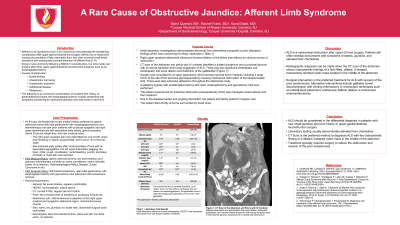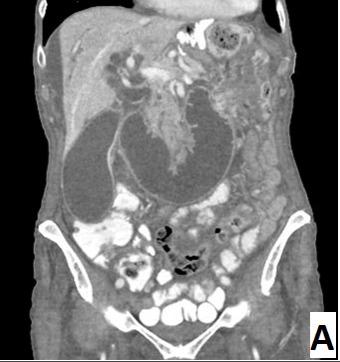Back


Poster Session E - Tuesday Afternoon
Category: Small Intestine
E0679 - A Rare Cause of Obstructive Jaundice: Afferent Limb Syndrome
Tuesday, October 25, 2022
3:00 PM – 5:00 PM ET
Location: Crown Ballroom

Has Audio

Mahir Qureshi, BS
Cooper Medical School of Rowan University
Camden, NJ
Presenting Author(s)
Mahir Qureshi, BS1, Rachel Frank, MD2, Kunal K. Dalal, MD2
1Cooper Medical School of Rowan University, Camden, NJ; 2Cooper University Hospital - Digestive Health Institute, Camden, NJ
Introduction: Afferent limb syndrome (ALS) is a rare but potentially life-threatening complication of upper gastrointestinal (GI) surgery and reconstruction causing distal obstruction of the biliopancreatic limb with subsequent accumulation of bile, pancreatic fluid, and other small bowel secretions upstream afferent limb dilation. It is imperative to recognize this complication postoperatively as buildup in the small bowel can result in bowel perforation requiring emergency surgery. We present a patient who developed ALS after upper gastrointestinal reconstruction with esophagojejunostomy for the treatment of gastric adenocarcinoma.
Case Description/Methods: An 84 year-old female with a past medical history of gastric adenocarcinoma with total gastrectomy and esophagojejunostomy presented to the emergency department with a subacute history of upper abdominal pain and new-onset jaundice. Initial labs were notable for elevated liver chemistries including alkaline phosphate level of 435 U/L (normal 39-117 U/L), alanine transaminase of 62 U/L (normal 6-45 U/L), and aspartate transaminase of 36 U/L (normal 10-25 U/L). Abdominal ultrasound demonstrated markedly dilated common bile and intrahepatic ducts and gallbladder distention without stones. CT scan of the abdomen confirmed the ultrasound findings, but also identified a dilated duodenum with an abrupt transition point in the proximal jejunum suggestive of ALS shown in Figure A. The patient underwent open laparotomy which demonstrated multiple tumor implants. A large implant at the site of the previous jejunojejunostomy was identified as the cause of afferent limb obstruction. A palliative bypass was performed. The patient had a complicated post-operative course. Ultimately, due to the extensive disease burden and ongoing patient discomfort, the patient and their family decided to pursue hospice care.
Discussion: ALS is a post-operative complication of upper GI tract surgery that involves mechanical obstruction of the biliopancreatic limb. Patients often present with jaundice. CT scan is the preferred diagnostic modality. First-line treatment involves surgery to relieve the obstruction with revision of the prior anastomosis. Although rare, this diagnosis should be considered in appropriate patients.

Disclosures:
Mahir Qureshi, BS1, Rachel Frank, MD2, Kunal K. Dalal, MD2. E0679 - A Rare Cause of Obstructive Jaundice: Afferent Limb Syndrome, ACG 2022 Annual Scientific Meeting Abstracts. Charlotte, NC: American College of Gastroenterology.
1Cooper Medical School of Rowan University, Camden, NJ; 2Cooper University Hospital - Digestive Health Institute, Camden, NJ
Introduction: Afferent limb syndrome (ALS) is a rare but potentially life-threatening complication of upper gastrointestinal (GI) surgery and reconstruction causing distal obstruction of the biliopancreatic limb with subsequent accumulation of bile, pancreatic fluid, and other small bowel secretions upstream afferent limb dilation. It is imperative to recognize this complication postoperatively as buildup in the small bowel can result in bowel perforation requiring emergency surgery. We present a patient who developed ALS after upper gastrointestinal reconstruction with esophagojejunostomy for the treatment of gastric adenocarcinoma.
Case Description/Methods: An 84 year-old female with a past medical history of gastric adenocarcinoma with total gastrectomy and esophagojejunostomy presented to the emergency department with a subacute history of upper abdominal pain and new-onset jaundice. Initial labs were notable for elevated liver chemistries including alkaline phosphate level of 435 U/L (normal 39-117 U/L), alanine transaminase of 62 U/L (normal 6-45 U/L), and aspartate transaminase of 36 U/L (normal 10-25 U/L). Abdominal ultrasound demonstrated markedly dilated common bile and intrahepatic ducts and gallbladder distention without stones. CT scan of the abdomen confirmed the ultrasound findings, but also identified a dilated duodenum with an abrupt transition point in the proximal jejunum suggestive of ALS shown in Figure A. The patient underwent open laparotomy which demonstrated multiple tumor implants. A large implant at the site of the previous jejunojejunostomy was identified as the cause of afferent limb obstruction. A palliative bypass was performed. The patient had a complicated post-operative course. Ultimately, due to the extensive disease burden and ongoing patient discomfort, the patient and their family decided to pursue hospice care.
Discussion: ALS is a post-operative complication of upper GI tract surgery that involves mechanical obstruction of the biliopancreatic limb. Patients often present with jaundice. CT scan is the preferred diagnostic modality. First-line treatment involves surgery to relieve the obstruction with revision of the prior anastomosis. Although rare, this diagnosis should be considered in appropriate patients.

Figure: Figure A: CT scan with markedly dilated intrahepatic and extrahepatic biliary ductal dilation, distended gallbladder, and markedly dilated duodenum with abrupt transition point in proximal jejunum
Disclosures:
Mahir Qureshi indicated no relevant financial relationships.
Rachel Frank indicated no relevant financial relationships.
Kunal Dalal indicated no relevant financial relationships.
Mahir Qureshi, BS1, Rachel Frank, MD2, Kunal K. Dalal, MD2. E0679 - A Rare Cause of Obstructive Jaundice: Afferent Limb Syndrome, ACG 2022 Annual Scientific Meeting Abstracts. Charlotte, NC: American College of Gastroenterology.
